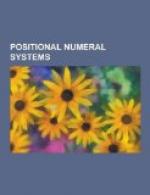|
This section contains 379 words (approx. 2 pages at 300 words per page) |
Although we are so used to a number system based on ten digits (0 through 9) that we take it for granted, systems based on other numbers are perfectly possible. The ancient Babylonians used a base-12 number system, while the Mayans employed a base-20 system. In the 1600s a brilliant German philosopher and mathematician, Gottfried Leibniz, studied and described the binary system of numbering. This base-2 system uses only two symbols, 0 and 1, to express all numbers. In the binary system, the number 10 represents the quantity 2--being one 2 and no 1s. Binary 11 is the same as decimal 3--one 2 plus one 1. Binary 111 is one 4, plus one 2, plus one 1, or decimal 7.
Leibniz appreciated the elegant simplicity of a two-symbol numbering system, and he also saw it as a symbolic proof of the existence of God: the unity (the 1) represented God, and 0 was the void; God had created everything out of nothing. Leibniz had earlier attempted to reduce logical thought to a form of mathematical calculation, and he saw the possibilities of using the binary system to reduce thought to its simplest form. His ideas were picked up by George Boole (1815-1864) in the nineteenth century as that Englishman developed his Boolean algebra.
The great value of binary mathematics emerged in the twentieth century, when several researchers realized that the base-2 system was ideally suited for computer design. Computers work via electronic circuits, and each circuit in the chain is either on or off, 1 or 0. A young German engineer, Konrad Zuse, designed an electronic calculator in the mid-1930s that used binary mathematics. John von Neumann and Alan Turing, two computer visionaries, foresaw the role of binary math for computers. George Stibitz of Bell Laboratories adapted binary notation to relay switching equipment in 1937 to produce a homemade computer. American computer pioneers John Atanasoff, John Mauchly, and J. Presper Eckert also utilized the binary system.
In 1941 Claude Shannon (1916-) of Bell Labs began examining the most efficient ways to transmit information. As early as 1938 he had studied the possibility of expressing language mathematically, and by 1948 he had done so, using the binary system. Data was reduced to a series of yes/no choices, a binary 1/0. Each binary digit became known in computer jargon as a bit, the basic unit of computer information.
|
This section contains 379 words (approx. 2 pages at 300 words per page) |


